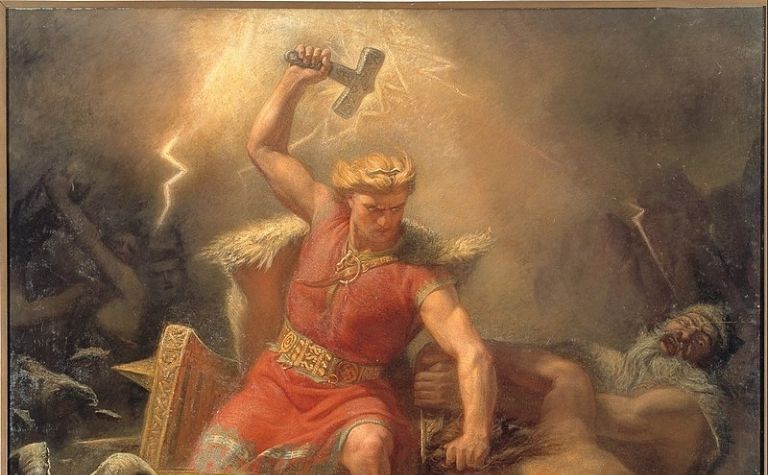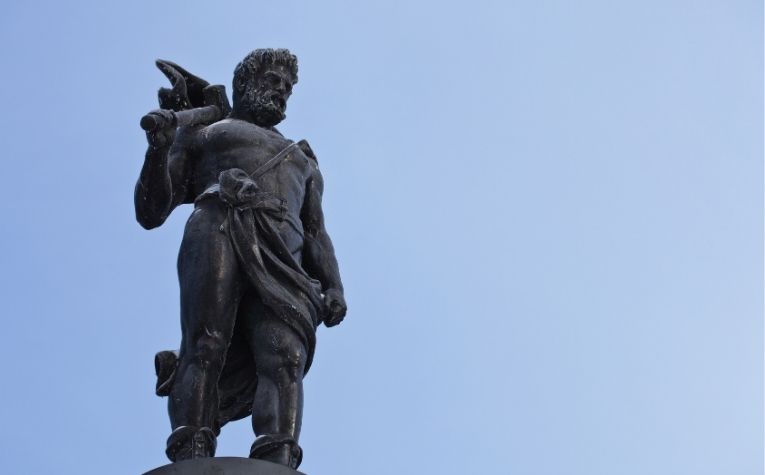Thor is known as the son of Odin, protector of the Nine Realms, wielder of the hammer Mjölnir, god of storms, sacred groves, strength, and most famously, lightning and thunder.
But what was Thor’s origin — how did he become the god of lightning and thunder?
Thor is the god of thunder because his hammer, Mjölnir, created thunder whenever it struck an enemy.
The Norse sagas described the Northern Germanic and Norse god of thunder as the pinnacle of good and the defender of his people and humanity against evil forces.
This article will explore the origins of Thor and his hammer, Mjölnir, and his relationship with humanity.
Also, see How Old Is Thor? to learn more.

Is Thor the God of Lightning?
Thor is the Northern Germanic god of lightning and thunder, among other associations.
The etymology of the name “Thor” (spelled “Þórr” in old Norse) is derived from the Proto-Germanic word “Þunraz,” which meant “thunder,” which in turn is derived from the Proto-Indo-European root word for thunder.
Through wielding the mighty Warhammer Mjölnir, Thor was also the god and maker of lightning.
Before advancements were made in science, humanity did not understand the relationship between lightning and thunder.
Scandinavians in the Middle Ages had no way of knowing that when an extreme amount of electricity jumps between clouds or from clouds to the ground, the air it passes through becomes superheated and expands at the speed of sound, which creates a loud “boom.”
As a result, lightning and the thunder it makes were often misunderstood to be two separate phenomena rather than cause and effect.
Also, see How Did Thor Lose His Eye? to learn more.

Did Thor’s Hammer Create Thunder and Lightning?
Thor wielded the great Warhammer Mjölnir, which shot thunder and lightning at Thor’s enemies when he swung it. And when he threw it at an enemy, it always returned to his hand like a boomerang.
This was described in Snorri Sturluson’s “Poetic Edda” and “Prose Edda.”
In Norse legends, Mjölnir was one of the many marvelous items forged by dwarven smiths, purported to be the most skilled and excellent craftsmen in all nine realms, at the behest of the trickster god Loki.
The giant Thrym once stole the hammer, which Thor took as a trophy after defeating the giant in honorable combat.
The origin of the word “Mjölnir” appears to be derived from a Proto-Germanic word meaning “lightning” or “lightning maker.”
However, other possible root meanings include “the color white,” “the grinder,” and “shining lightning weapon.”
In Norse culture, Thor’s hammer was a powerful and central symbol of blessing and consecration. It was invoked as a symbol of life to bless many ceremonies, including weddings, births, and possibly funerals.
One episode related in Sturluson’s Prose Edda tells of a time Thor was forced by hunger to kill and eat his herd of goats, only to resurrect them with Mjölnir by “hallowing their bones.”
The Norse sagas say the hammer never failed Thor, and after his predestined death during the battle at the end of the world (Ragnarok), it would serve his sons Móði and Magni just as well.
Also, see Do Norwegians Still Believe in Thor? to learn more.
Does Thor Use His Powers for Good or Evil?
Thor was described as a great warrior for good and paragon of all that’s honorable. His deeds are mentioned in many Norse and Northern Germanic poems and legends.
Using his strength and intelligence, he fought many battles to protect the inhabitants of the Nine Realms.
One of Thor’s greatest enemies was the evil sea serpent Jormungandr who encircled the human-inhabited world of Midgard (Earth) who sought the destruction of the people therein.
In one tale told in the Eddas, the king of the giants challenged Thor to lift his cat as a test of strength. Unknown to Thor, the cat is actually Jormungandr in disguise.
Being the strongest god in existence, Thor easily lifts the disguised serpent and earns significant praise from the giants.
In another tale, Thor fishes Jormungandr from the sea, and the two fight a great battle.
But before Thor can deliver the killing blow with Mjölnir, Thor’s giant companion cuts the fishing line and allows the serpent to sink back into the depths.
A third tale recounts Jormungandr’s role in the foretold end of the world, Ragnorak. Thor and Jormungandr are destined to fight an apocalyptic battle to their mutual deaths.
Besides his role as the paragon of warriors, Thor played an essential part in introducing and promoting agriculture on Midgard (Earth).
He would bless the land with rain and enable crops to grow.
According to Adam of Bremen, an 11th-century German historian, Thor “presides over the air, which governs the thunder and lightning, the winds and rains, fair weather and crops.”
The Norse sagas also said that through his divine marriage with the goddess Sif, Thor promoted bountiful harvests.
While he was the greatest warrior ever to exist, Thor didn’t always resort to brute force to accomplish his wondrous deeds. For instance, to save the goddess Freya from an unwanted marriage to a giant and reclaim his stolen hammer, Thor disguised himself in a wedding dress and attended the wedding in Freya’s place.
With the help of Loki, the god of mischief and magic, Thor was able to make it through the wedding without shedding his disguise and reclaiming Mjölnir.
Thor then killed the giant groom and the wedding guests. This tale illustrated how clever Thor was.
Who Was Thor?
According to Norse legends, Thor is the son of Odin and the giantess Jord. Thor was one of the Aesir, the principal pantheon of Norse gods who hailed from the divine realm of Asgard.
People described Thor as a red-haired middle-aged man with a full beard, massive strength, and great intellect.
Described as “the strongest of gods and men,” Thor is one of the numerous gods created by the descendants of the prehistoric Proto-Indo-Europeans in an attempt to explain and understand the natural world.
They’re believed to have been a group of semi-nomadic farming and herding tribes who migrated out of the Russian Steppes sometime in the Neolithic Era, between 7500 BC and 4500 AD.
They either conquered or replaced the populations of much of the Eurasian continent from the Iberian Peninsula, which is modern Spain and Portugal, to the Indian Subcontinent.
While they didn’t leave written records behind, their legacy is preserved in the languages, and religions descended from their culture.
In the legend of Thor, the prehistoric Norse took one of the worst natural agents of destruction, lightning, and turned it into an instrument of good and justice.
References:
[1] Source
